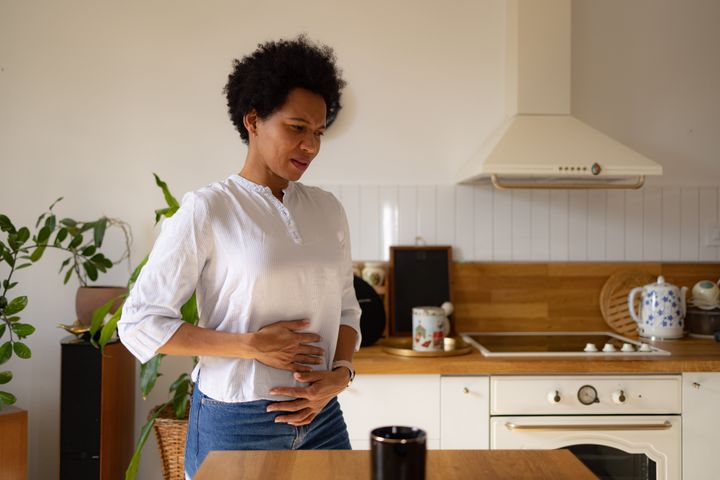
The BBC’s Naga Munchetty has just revealed that she has adenomyosis – but what exactly is the condition, and how common is it?
Munchetty, a host for BBC Breakfast and BBC Radio 5 Live, explained on Monday how she lives with a constant, acute pain in her womb.
She said she almost fainted while hosting BBC Breakfast once because of the agony, and that she avoids wearing pale trousers just in case her period, worsened by the condition, leaks through her clothing.
She told The Independent: “I’m living in pain. I live in pain at this moment. I would say I’m in level three or four. I live every day on painkillers. I have done for the past year. I’m angry and I’m really upset. I’m really upset that I have to do this.”
But until her diagnosis eight months ago, Munchetty said she had never heard of it before – despite having very painful periods from the age of 16.
What is adenomyosis?
The NHS described it as “where tissue which normally lines the womb starts to grow inside the muscular wall of the womb”. It can affect either the whole womb or just one part.
“This extra tissue can make your periods particularly painful and cause pelvis pain,” according to the NHS in Scotland.
It’s not life-threatening, but it can have a major impact on your day-to-day life, as Munchetty noted.
In fact, one in 10 women are estimated to have adenomyosis, but it’s very hard to diagnose – so plenty of people might not be aware that they have it.
What are the symptoms of adenomyosis?
You can be asymptomatic with this condition, or you might experience the following:
- Heavy periods that last for a long time
- Painful periods
- Pain during sex
- Pain when going to the toilet to poo
- Bleeding between periods
- Worsening uterine cramps
- Pain in the pelvis area
- Feelings of pressure in your bladder or rectum
- Your uterus may feel larger, and more tender
- Bloating
What is adenomyosis belly?
Occasionally, severe cases can lead to an enlarged uterus which makes the uterine walls thicker, putting pressure on neighbouring organs and potentially making your stomach stick out.
This is sometimes known as adenomyosis belly, and according to Fibroid Fighters, can look like a pregnancy between three to six months.

How do you get diagnosed with adenomyosis?
The NHS explained doctors have to carry out a pelvis examination first when diagnosing the condition, which includes looking at the vulva, vagina and cervix.
A specialist may then carry out more tests, including an ultrasound or an MRI scan to rule out other conditions, before concluding that it might be adenomyosis.
Who can get adenomyosis?
It not clear what can cause adenomyosis, but it is not an infection, contagious nor is it cancerous.
The Mayo Clinic’s researchers think that it might be caused by invasive tissue growth, possibly after uterine incision such as C-section.
They also speculated that uterine inflammation from childbirth could be responsible, as could stem cells which invade the uterine muscle. Alternatively, some could just be born with it.
According to US outlet WebMD, your risk of developing the condition does increase if you:
- Are in your 40s or older
- Have given birth at least once
- Started your period at age 10 or younger
- Have menstrual cycles that last 24 days or less.
What is the difference between adenomyosis and endometriosis?
Both conditions describe difficulties with the endometrial tissue found in the womb – but adenomyosis is often described as “evil twin sister” to endometriosis.
During endometriosis, endometrial tissues grows outside your uterus, on your ovaries or fallopian tubes.
During adenomyosis, endometrial tissue grows into the womb wall.
For both conditions, this tissue then continues to respond to hormonal changes in the menstrual cycle, and so it thickens, breaks down and causes bleeding.
This can therefore lead to anaemia – as Endometriosis UK explained.
As Houston Fibroids also suggested: “For many women, [adenomyosis] triggers symptoms that are far more invasive than those associated with endometriosis.”
But, endometriosis is harder to diagnose. For most women, the condition can only be officially identified through laparoscopic surgery, where a thin tube is inserted into the stomach to see lesions, cysts and adhesion.
Adenomyosis on the other hand is identifiable through MRI, or trans-vaginal ultrasound.
How is adenomyosis treated?
There are several different options according to which symptoms are causing the sufferer the most problems.
Those with the condition can take anti-inflammatory medication to relieve pain or can get treatment for their period to reduce the amount of menstrual blood loss.
Hormone therapy like the contraceptive pill can also control heavy periods, and finally, the womb can be surgically removed.
The NHS explained: “A hysterectomy can cure adenomyosis but will only be considered if all other treatments have failed and you do not want to have any more children.”